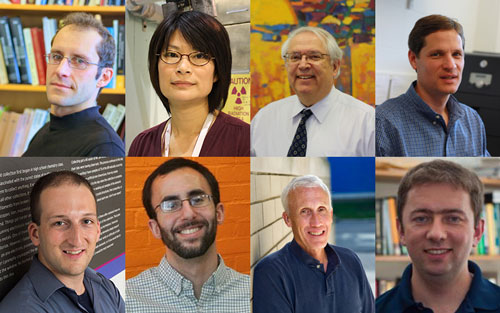MIT research teams win 2015 Department of Energy NEUP awards

MIT research teams have received funding through five separate Department of Energy (DOE) Nuclear Energy University Programs (NEUP) and Nuclear Energy Enabling Technologies (NEET) grants.
A team led by NSE’s Mujid Kazimi (PI) and Kord Smith (co-PI) received $3M over 3 years for the “Development of Accident Tolerant Fuel Options For Near Term Applications”. Researchers will develop computational tools to evaluate accident tolerant fuel (ATF) options for near term applications. The computational tools will be predominantly developed under the NEAMS framework and will include: RattleSNake, MARMOT, BISON and RELAP-7. These codes will be further enhanced in order to model ATF options. The integrated research project (IRP) involves two industry collaborators (AREVA and Anatech), three other universities (U. of Wisconsin, Texas A&M, and Penn State U.), Idaho National Laboratory, and Koroush Shrivan, Thomas McKrell, Michael Short and Jacopo Buongiorno at MIT.
NSE professor Michael Short also won an NEUP R&D grant of $800K for his work on “Multilayer Composite Fuel Cladding for LWR Performance Enhancement and Severe Accident Tolerance”. Short and his team will develop, manufacture, and weld a new multimetallic layered composite (MMLC) for enhanced severe accident tolerance and manufacturability in LWRs. Layers of stainless steel (facing the coolant) and Zircaloy (facing the fuel) will be separated by barrier layers of Cr and Nb. Severe accident testing in 1200C steam, LWR autoclave testing, and ion irradiation studies will demonstrate the MMLC's microstructural stability. In addition Short will receive $200K through a collaboration with Texas A&M on corrosion testing of TiN-coated Zircaloy in PWR water (using the Short Lab’s CRUD loop) and molten sodium.
MIT Nuclear Reactor Lab’s Lin Wen Hu and David Carpenter are part of the team led by Oregon State University which received an IRP grant to work on “Computational and Experimental Benchmarking for Transient Fuel Testing”. Researchers will perform a benchmark of the Transient Reactor Facility located at the Idaho National Laboratory. This benchmark will include two steady state neutronic benchmark problems and two transient benchmark problems. It will include the design, construction and utilization of a full-scale representation of an in-pile flow loop prototype for TREAT and numerical benchmarking against the experimental data gained from the experiment.
Finally, DMSE’s Michael Demkowicz will collaborate with researchers at the University of Nebraska Lincoln, on “Radiation tolerance and mechanical properties of nanostructured amorphous-ceramic/metal composites”. The NEET R&D award for just under $1M supports the team who will use a non-traditional approach to design amorphous-ceramic/metal composites for service in extreme irradiation environments. Rather than try to prevent microstructure changes in polycrystalline aggregates, researchers will evolve composite systems where one of the constituents is intentionally synthesized in a non-crystalline or “amorphous” state. These materials may serve as the basis for developing a new class of structural materials with unprecedented resistance to radiation.
In FY 2015 the DOE is awarding approximately $31 million for 43 university-led nuclear energy research and development projects, approximately $13 million for 4 Integrated Research Projects, and 9 infrastructure support awards through the NEUP. The DOE is also awarding over $8.5 million to support 10 nuclear energy research and development projects through the NEET program.
- Jacopo Buongiorno
- Lin-wen Hu
- Michael Short
- Koroush Shirvan
- Three MIT-led research teams win 2014 Department of Energy NEUP awards
- NEUP
photo top L to R: Buongiorno, Hu, Kazimi, McKrell; bottom L to R: Short, Shrivan, Smith, Demkowicz
